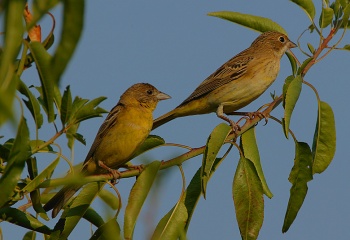(Reference updated) |
(References updated) |
||
| Line 1: | Line 1: | ||
| − | [[Image:Black-headed_Bunting.jpg|thumb|550px|right|Photo by {{user|Martin+Creasser|Martin Creasser}}<br />[[Lesvos]], [[Greece]]]] | + | [[Image:Black-headed_Bunting.jpg|thumb|550px|right|Photo by {{user|Martin+Creasser|Martin Creasser}}<br />[[Lesvos]], [[Greece]], May 2003]] |
;[[:Category:Emberiza|Emberiza]] melanocephala | ;[[:Category:Emberiza|Emberiza]] melanocephala | ||
==Identification== | ==Identification== | ||
| Line 31: | Line 31: | ||
''[[Media:Emberiza melanocephala (song).mp3|Listen in an external program]]'' | ''[[Media:Emberiza melanocephala (song).mp3|Listen in an external program]]'' | ||
==References== | ==References== | ||
| − | #{{Ref- | + | #{{Ref-Clements6thOct12}}#Wikipedia |
{{ref}} | {{ref}} | ||
==External Links== | ==External Links== | ||
Revision as of 10:13, 30 May 2013
- Emberiza melanocephala
Identification
16cm
The males have black heads, brilliant yellow underparts and rich reddish-brown upperparts.
The females are much duller although they often show at least a hint of yellow, especially on the undertail coverts and the head is usually distinctly darker than the throat, creating a hooded effect which mimics the pattern of the male.
Otherwise they look like big, fairly long-bodied buntings with an obvious white eye-ring, rather sandy-brown plumage, a striking pale wing panel and a rich chestnut coloured rump. The lack of white outer-tail feathers also separates them from most other buntings.
Similar Species
Female and immature birds are very similar to Red-headed Bunting.
Distribution
Common in the south-east of the Western Palearctic, breeds on the east coast of the Adriatic from Slovenia to southern Greece, also in south Serbia and Macedonia, the Aegean coast of Greece and most islands, European Turkey, Bulgaria and north on the Black Sea coast to the Danube Delta. In Turkey breeds almost throughout (except north coast) and east to northern Iraq and Transcaucasia. Absent from the Caucasus but occurs further north from Crimea and eastern Sea of Azov east to the Caspian. Also breeds on Cyprus and in the Middle East south to northern Israel and west Jordan.
Increasing and now fairly widespread in Italy and records from south-east France have increased in recent years culminating in the first proven breeding there in 2000.
Migratory, leaving breeding areas late July-August and moving south-eastwards to winter in western India, returning late April-early May.
Frequent vagrant outside usual range and recorded throughout Europe north to Iceland, Scandinavia and Estonia, and west to Spain and North-West Africa. British records (c.166) mostly in May-June, also in July-October, the majority occur in Shetland, others well-scattered throughout Britain. Also recorded in the Channel Islands.
Taxonomy
This is a monotypic species[1].
Habitat
Scrub, open woodland.
Behaviour
Diet
The diet includes seeds; also invertebrates in breeding season.
Vocalisation
<flashmp3>Emberiza melanocephala (song).mp3</flashmp3>
Listen in an external program
References
- Clements, J. F., T. S. Schulenberg, M. J. Iliff, B.L. Sullivan, C. L. Wood, and D. Roberson. 2012. The eBird/Clements Checklist of Birds of the World. 6th ed., with updates to October 2012. Ithaca: Cornell Univ. Press. ISBN 978-0801445019. Spreadsheet available at http://www.birds.cornell.edu/clementschecklist/downloadable-clements-checklist
- Wikipedia
Recommended Citation
- BirdForum Opus contributors. (2025) Black-headed Bunting. In: BirdForum, the forum for wild birds and birding. Retrieved 19 May 2025 from https://www.birdforum.net/opus/Black-headed_Bunting
External Links







